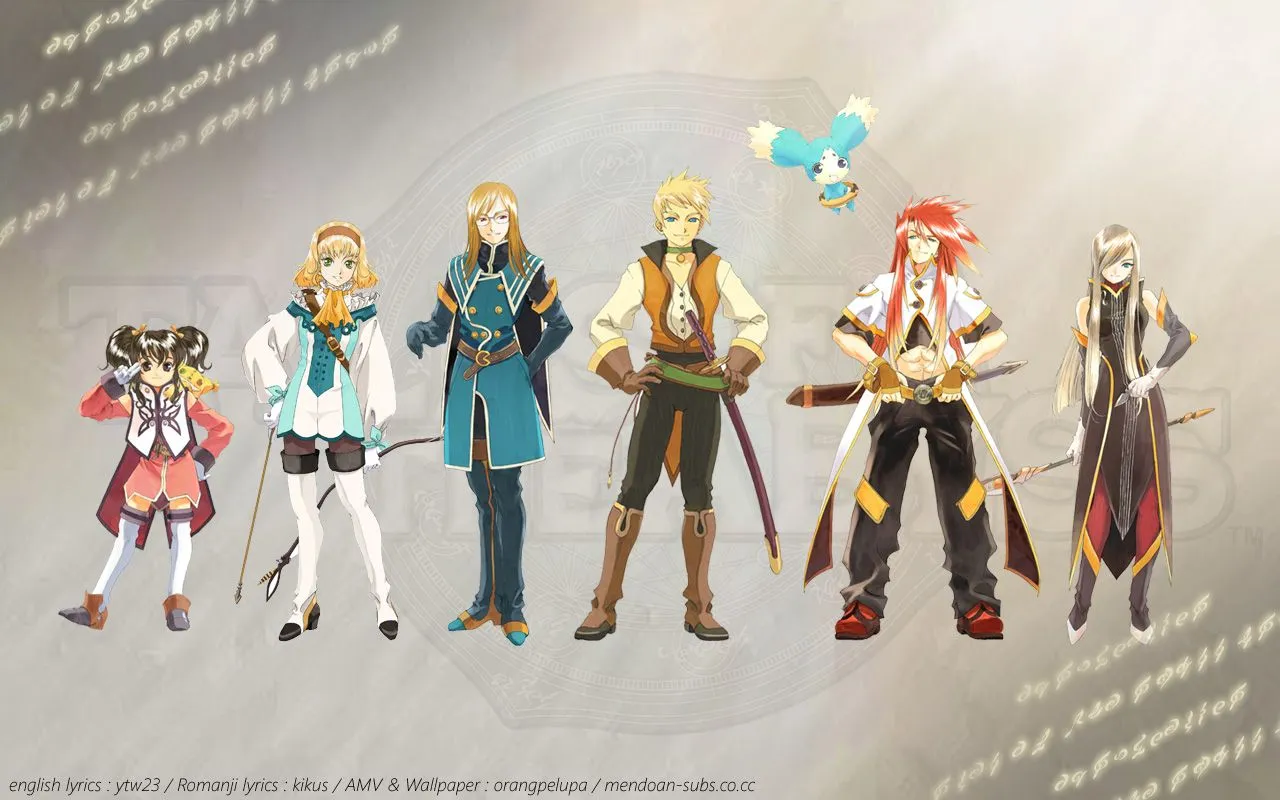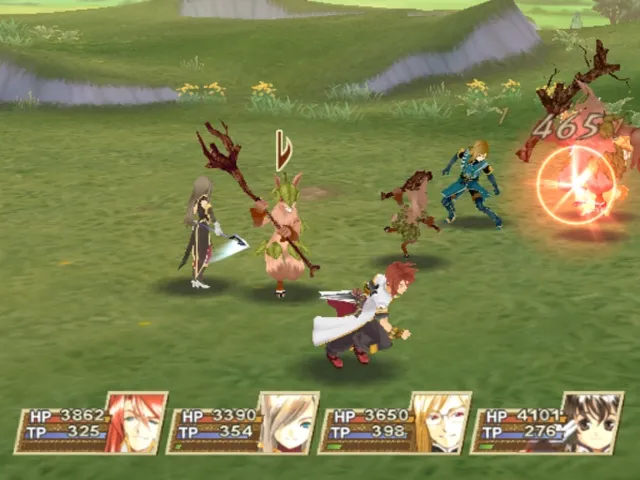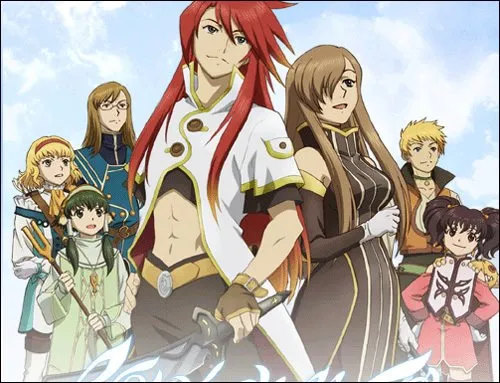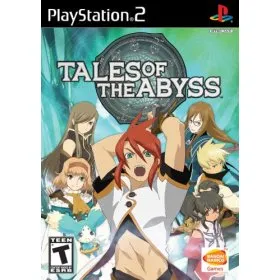Game: Tales of the Abyss.
Genre: RPG.
Platforms: PlayStation 2.
The world of video games sometimes gives you pleasant surprises. When I thought that I would never find an RPG that could fill me up again, when I thought that I would never say that "I'm going to stop playing, go and finish it", ZAS. I run into the Tales saga.
I loved Eternia, and it's a great game, but it lacked something to be really great. That something that is missing is all that Tales of the Abyss has. A gigantic game from every possible point of view.
ND2000, In Kimlasca someone will be born who will inherit the power of Lorelei, he will be a boy of noble blood and red hair. He will be known by the name of "the light of the sacred flame."
We are on Auldrant, the planet where we will star in our entire adventure. Auldrant is made up of particles called phonons. Magic, technology, everything makes use of phonons. It was understood that there were 6 different types of phonons, but a girl named Yulia discovered the 7th phonon. This fact caused that the spirit of the planet, Lorelei, entrusted to Yulia the total knowledge of the future of Auldrant and of humanity, from its birth to its destruction.
After this Yulia wrote the entire future of Auldrant on stone tablets that were distributed throughout the world. These stones are known today as La Partitura. As you can imagine, the value of The Score in Auldrant is inconceivable, whoever knows The Score will know the exact future of things. This has caused the two great empires of Auldrant, Kimlasca and Malkuth to be constantly at odds over obtaining their fragments.
In this context we take on the role of Luke, nephew of the King of Kimlasca. Luke was kidnapped at the age of eleven by Malkuth, this fact made him completely lose his memory. Because of this, to protect him, Luke was prohibited from leaving his mansion until he was of legal age. A somewhat extreme measure, but very effective.
One day like any other, Luke's teacher, Van, shows up at the mansion to tell him that he has to leave to look for Ion, the lead phonic master of the Order of Lorelei (an order in charge of mediating and protecting the distribution of the score), which has mysteriously disappeared. To make up for this absence, Van gives Luke one last intensive class. But in the middle of this, a mysterious woman sneaks into the mansion by putting the staff to sleep through an phonic hymn and tries to attack Master Van. Luke, in an attempt to defend him, confronts this girl. But when her swords collide, a great light originates teleporting Luke and the mysterious woman to an unknown forest.
From there we can say that Tales of The Abyss begins, with a Luke who wants to return to his mansion and a girl, Tears, who feels guilty for having involved this boy in a matter that does not concern him at all.
How to put it, the story of Tales of the Abyss is colossally long and complex. In the first 10 hours we will not even know where we have been. We will feel, like Luke, totally ignorant of the events that happen. We will be bombarded with so much information, names, places and events that it will cost us a world to follow. But this is nothing more than a mere sign that we are facing something gigantic, before the foundations of a very elaborate, convoluted and complex story that, once we begin to understand what is happening, we will not be able to detach ourselves from the television.
As you may have imagined, it is not the typical story that you know what is going to happen after two hours of play, nor the extremely popular topic of good versus evil. Tales of The Abyss is above all that, it is an adult, intimate story. A story with a message that touches on topics such as biogenetics, redemption, the value of living, religion, politics ... Tales of the Abyss is the typical game that we would sit down to play all those ignorant people who believe that video games They are children's things and they don't teach anything. Tales of the Abyss transmits values, excites and surprises.
It also has a repertoire of characters that I would dare to label as one of the most interesting that I have come across in a video game. Luke wants to give him two wares in the first hours of play, Anise would simply drown her with a bag from the carrefour. Tears turns me on, instead. I could continue with the other characters but I think you have gotten the message, we can fall better or worse but that is precisely what is great about this game, that the characters convey emotions to us. And that is something that very, very few games have the privilege of achieving.
If there is something to be said about the story, I would say that it takes a long time to get off the ground. As I already said, the first 10 hours we will witness a brutal avalanche of information that we do not understand Not half. I understand that someone here can get "bored" by not clearly knowing where the script is heading. Although I say that that is better than knowing how the game is going to end in two hours, right? In any case, with a little patience we will discover that we are facing a great story full of twists and turns and in which surprising things will not stop happening continuously.
Something great about Tales of The Abyss (and that already happened in other Tales, but it deserves to dedicate a few lines to it) is that throughout the adventure, we can constantly witness, optionally, sequences of our characters talking to each other. Conversations ranging from 20 to 50 seconds. This, although it seems silly, is something fundamental to know more and better the characters, their way of thinking, speaking, their affinities, everything. From the real-time sequences of Final Fantasy IX I did not come across such a good implementation in an RPG. Much guilt that the characters transmit so much to us is this system, of course.
ND2002, he who craves glory will destroy the island where he was born.
The combats in Tales of The Abyss are very similar to those in Eternia, but with the difference that we will be able to move in a 3D environment. We will no longer have all the enemies together on one side of the screen, but they will be scattered throughout the area.
The system for learning and using skills (called Arts) is kept intact and some new things are implemented such as Bonus Skills, Capacity Cores, and Hollow Chambers. A brief explanation of each one so that you can miss us:
The additional abilities are passive abilities that give us certain privileges within the combats. For example, we can learn an additional skill that consists of having a greater probability of landing more critical hits to enemies, or another of having greater defense against some state, etc. These abilities also "activate" certain behaviors in combat. For example, we will not be able to move in a 3D environment until we learn an additional skill that allows us to do so (don't worry, you learn at the beginning). The amount of additional skills is immense. To give you an idea, I, after 60 hours of play, have not even half the additional skills available learned.
The Ability Cores are, let's say, "badges" that are equipped to the characters to enhance certain specific stats. More physical defense and agility, for example. Or more magic attack and physical defense… there are all kinds of combinations. We will be the ones who have to find the ones that best suit the way our characters fight.
Finally we have the Fonorlot Chambers. This system allows us to introduce phonons to our arts to improve them. Each art has a certain number of slots (yes, as if they were the subjects in FFVII) to which we can introduce specific phonons to vary the effect of the skill. For example, so that it consumes less amount of TP, or that the effect of the art is greater, etc. The amount of available phonons is relatively small (especially due to the number of different arts that there are), so we have to think very well how to use them.
Another important addition in Tales of the Abyss that is applied within combat is the phonon fields. When a character performs a spell, a phonon field of a certain state appears on the ground that lasts for a limited time. At that time, if we place ourselves on top of the phonon field and perform an art related to that state, we will be able to enhance our art, causing greater damage to the enemy.
I don't know if you realize how many strategic elements this game has. That an action RPG has a more complex combat system than most tactics, or turn-based combat, says a lot about the quality of this title.
Graphically, the game is more than enough, although it is true that if we take into account the year in which it came out (nothing ago, in 2006) we could have demanded something more. Look for example Final Fantasy XII, almost the same time and how stupid it is. Anyway, it is totally enjoyable and very pleasant to play.
The OST, although magnificent, I liked the one from Eternia better. But I suppose this is already a matter of taste.
As a curiosity to tell you that the composer of this game is the same one who made the OST to Eternal Sonata. Great soundtrack too.
Oh, and the opening is glorious.
Conclution.
If I put Tales of Eternia through the roof, I should canonize him and pray to him every day, because he is, objectively, superior in all respects to that game.
A great story, huge characters, an inordinate duration (not counting extras, there is plenty of time too), a very careful development, a unique combat system. Tales of the Abyss has it all. Out there surely there will be people who complain that it falls into clichés, or that it does not reinvent the genre, or that development is linear, blah. Bullshit. Everything this game does, it does incredibly well. And it shows that you don't need to reinvent anything to achieve glory.
Tales of the Abyss is a unique experience. One of the best RPGs in history, I tell you.




